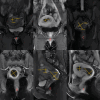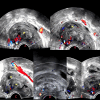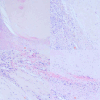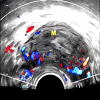Hysteroscopic Myomectomy for Type 2 Submucosal Myoma Pretreated by HIFU and Mifepristone Treatment: A Case Report and Literature Review
- PMID: 40787589
- PMCID: PMC12333630
- DOI: 10.2147/IJWH.S530879
Hysteroscopic Myomectomy for Type 2 Submucosal Myoma Pretreated by HIFU and Mifepristone Treatment: A Case Report and Literature Review
Abstract
Hysteroscopic myomectomy is the first-line treatment for the removal of submucosal myoma in women facing fertility requirements. However, in the face of large diameter type 2 submucosal myoma, patients are at greater risk of complications such as uterine perforation and fluid overload during hysteroscopy. When the diameter of type 2 submucous myoma is greater than 4cm, the three-phase treatment of high intensity focused ultrasound (HIFU), drugs and hysteroscopy is effective and safe. We shared a case of a 30-year-old non-pregnant woman, who had a history of uterine submucous myoma for more than 4 years with symptoms of heavy menstruation, prolonged menstruation and secondary severe anemia. The patient's initial pelvic magnetic resonance results suggested a type 2 uterine submucous myoma with a diameter of more than 4cm. We first performed HIFU on the patient, followed by the patient's oral intake of mifepristone tablets for 3 months, and prior to hysteroscopic surgery, the patient's fibroid type was shifted to type 0, and finally successfully completed hysteroscopic myomectomy (HM). Finally, we conclude that when the diameter of type 2 submucosal myoma exceeds 4 cm, preoperative application of HIFU combined with drug treatment should be considered to maximize the reduction of fibroids, improve symptoms such as anemia and dysmenorrhea, reduce the time required for hysteroscopic surgery, and improve the safety of surgery.
Keywords: high intensity focused ultrasound; hysteroscopic myomectomy; mifepristone; submucous myoma of uterus; uterine fibroid.
© 2025 Li et al.
Conflict of interest statement
Junjie Li is now affiliated with Traditional Chinese Medicine Department, Hunan University of Medicine General Hospital, Hunan, Huaihua, 418000, People’s Republic of China. All authors declare that there is no conflict of interest in this study.
Figures





Similar articles
-
Feasibility of single step hysteroscopic myomectomy: fibroid size is the most significant factor based on data from a single centre and surgeon.Facts Views Vis Obgyn. 2025 Jun 27;17(2):110-120. doi: 10.52054/FVVO.2025.10. Epub 2025 May 27. Facts Views Vis Obgyn. 2025. PMID: 40423569 Free PMC article.
-
Preoperative medical therapy before surgery for uterine fibroids.Cochrane Database Syst Rev. 2025 Apr 4;4(4):CD000547. doi: 10.1002/14651858.CD000547.pub3. Cochrane Database Syst Rev. 2025. PMID: 40183418
-
Hysteroscopy for treating subfertility associated with suspected major uterine cavity abnormalities.Cochrane Database Syst Rev. 2015 Feb 21;(2):CD009461. doi: 10.1002/14651858.CD009461.pub3. Cochrane Database Syst Rev. 2015. Update in: Cochrane Database Syst Rev. 2018 Dec 05;12:CD009461. doi: 10.1002/14651858.CD009461.pub4. PMID: 25701429 Updated.
-
A utero-pelvic fistula and pelvic-parasitic myoma by hysteroscopic resection of a recurrent submucosal myoma: a case report.Front Med (Lausanne). 2025 Jun 20;12:1579105. doi: 10.3389/fmed.2025.1579105. eCollection 2025. Front Med (Lausanne). 2025. PMID: 40620430 Free PMC article.
-
Minimally invasive surgical techniques versus open myomectomy for uterine fibroids.Cochrane Database Syst Rev. 2014 Oct 21;2014(10):CD004638. doi: 10.1002/14651858.CD004638.pub3. Cochrane Database Syst Rev. 2014. PMID: 25331441 Free PMC article.
References
-
- American Association of Gynecologic Laparoscopists (AAGL): Advancing Inimally Invasive Gynecology Worldwide. AAGL practice report: practice guidelines for the diagnosis and management of submucous leiomyomas. J Minim Invasive Gynecol. 2012;19(2):152–171. doi: 10.1016/j.jmig.2011.09.005 - DOI - PubMed
-
- Munro MG, Critchley HOD, Fraser IS. FIGO menstrual disorders committee. The two FIGO systems for normal and abnormal uterine bleeding symptoms and classification of causes of abnormal uterine bleeding in the reproductive years: 2018 revisions [published correction appears in Int J Gynaecol Obstet. 2019 Feb;144(2):237]. Int J Gynaecol Obstet. 2018;143(3):393–408. doi: 10.1002/ijgo.12666 - DOI - PubMed
Publication types
LinkOut - more resources
Full Text Sources

